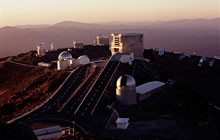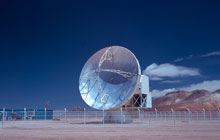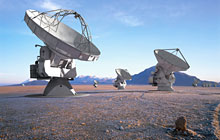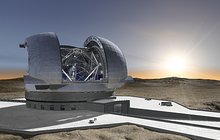Telescopi e Strumentazioni
Come stabilito nella propria convenzione, l'ESO fornisce agli astronomi europei strutture di ricerca d'avanguardia e promuove e organizza la cooperazione nella ricerca astronomica. Oggi l'ESO gestisce alcuni tra gli strumenti osservativi più grandi e più avanzati al mondo, nei suoi tre siti nel nord del Cile: La Silla, Paranal e Chajnantor. Questi sono i migliori luoghi per le osservazioni astronomiche che si conoscano nell'emisfero australe. Insieme ad altre attività, come lo sviluppo tecnologico, i convegni e i progetti educativi, l'ESO ha un ruolo decisivo nella creazione di un'Area per la Ricerca Europea in Astronomia e Astrofisica.
Osservatorio del Paranal
 Il Very Large Telescope (VLT), collocato sul Cerro Paranal, è il sito principale dell'ESO per le osservazioni in luce visibile e infrarossa. I quattro telescopi di 8,2 metri di diametro (UT) funzionano indipendentemente con un grande numero di strumenti.
Il Very Large Telescope (VLT), collocato sul Cerro Paranal, è il sito principale dell'ESO per le osservazioni in luce visibile e infrarossa. I quattro telescopi di 8,2 metri di diametro (UT) funzionano indipendentemente con un grande numero di strumenti.
Il VLT offre anche la possibilità di combinare la luce proveniente dai quattro UT in modo da fungere da interferometro. Il Very Large Telescope Interferometer (VLTI), con il proprio insieme di strumenti, fornisce immagini che raggiungono la risoluzione del milliarcosecondo e astrometria (la misura delle posizioni dei corpi celesti) con una precisione dell’ordine di 10 microarcosecondi. Il VLTI è composto, oltre che dai telescopi di 8,2 metri di diametro, da quattro Telescopi Ausiliari (Auxiliary Telescopes: AT) di 1,8 metri di diametro che migliorano le sue capacità di produrre immagini ad alta risoluzione e consentono il pieno funzionamento notturno durante tutto l’anno.
Inoltre, due telescopi per survey sono in funzione a Paranal: il VLT Survey Telescope (VST, di 2,6 metri di diametro) per il visibile, e il Visible and Infrared Survey Telescope for Astronomy (VISTA, di 4,1 metri di diametro) per l’infrarosso.
Il VLT è visibile anche su Google Maps, insieme con una raccolta di fotografie scattate dai visitatori. Le informazioni sulle visite ai siti dell'ESO sono disponibili in una pagina separata.Osservatorio di La Silla
 L'ESO gestisce due telescopi principali (il telescopio “3.6” di 3,6 metri e il New Technology Telescope (NTT)) all'osservatorio di La Silla. Sono dotati di strumenti all'avanguardia costruiti o per intero dall'ESO o da consorzi esterni con importanti contributi dell'ESO.
L'ESO gestisce due telescopi principali (il telescopio “3.6” di 3,6 metri e il New Technology Telescope (NTT)) all'osservatorio di La Silla. Sono dotati di strumenti all'avanguardia costruiti o per intero dall'ESO o da consorzi esterni con importanti contributi dell'ESO.
La Silla è visibile su Google Maps, insieme con alcune fotografie scattate dai visitatori. Le informazioni sulle visite ai siti dell'ESO sono disponibili in una pagina separata.
APEX
 L'Atacama Pathfinder Experiment (APEX) è frutto di una collaborazione fra l'Istituto Max Planck per la Radio Astronomia (MPIfR) al 55%, l'Onsala Space Observatory (OSO) al 13%, e l'European Southern Observatory (ESO) al 32%, volta a costruire e gestire il prototipo di una delle antenne di ALMA come un telescopio indipendente nel sito della piana di Chajnantor, a 5100 metri di altezza. Il telescopio è stato costruito dalla VERTEX Antennentechnik di Duisburg (Germania). APEX ha un insieme di spettrometri a eterodina e camere bolometriche a campo largo che operano in buona parte della finestra atmosferica tra 0.2 e 1.4 millimetri. Il telescopio è gestito da ESO.
L'Atacama Pathfinder Experiment (APEX) è frutto di una collaborazione fra l'Istituto Max Planck per la Radio Astronomia (MPIfR) al 55%, l'Onsala Space Observatory (OSO) al 13%, e l'European Southern Observatory (ESO) al 32%, volta a costruire e gestire il prototipo di una delle antenne di ALMA come un telescopio indipendente nel sito della piana di Chajnantor, a 5100 metri di altezza. Il telescopio è stato costruito dalla VERTEX Antennentechnik di Duisburg (Germania). APEX ha un insieme di spettrometri a eterodina e camere bolometriche a campo largo che operano in buona parte della finestra atmosferica tra 0.2 e 1.4 millimetri. Il telescopio è gestito da ESO.
ALMA
 L'Atacama Large Millimeter/submillimeter Array, o ALMA, è una collaborazione internazionale per gestire un telescopio dal progetto rivoluzionario che serve per osservare l'Universo da un sito nei contrafforti delle Ande Cilene. ALMA è costituito da una schiera di 66 grandi antenne di alta precisione che operano a lunghezze d'onda comprese tra i 0,32 e i 3,6 mm. La schiera principale da 12 metri è costituita da cinquanta antenne ciascuna di 12 metri di diametro, che funzionano insieme come un unico telescopio: un interferometro. Questa è integrata da un'ulteriore schiera compatta di quattro antenne di 12 metri di diametro e dodici antenne da 7 metri di diametro. Le antenne di ALMA possono essere disposte in diverse configurazioni, con la massima distanza tra le antenne che può variare tra i 150 metri e i 16 chilometri. Il correlatore di ALMA, un computer altamente specializzato che combina le informazioni ricevute dalle singole antenne, è in grado di eseguire la notevolve quantità di 16 000 milioni di milioni (1,6 x 1016) di operazioni al secondo.
L'Atacama Large Millimeter/submillimeter Array, o ALMA, è una collaborazione internazionale per gestire un telescopio dal progetto rivoluzionario che serve per osservare l'Universo da un sito nei contrafforti delle Ande Cilene. ALMA è costituito da una schiera di 66 grandi antenne di alta precisione che operano a lunghezze d'onda comprese tra i 0,32 e i 3,6 mm. La schiera principale da 12 metri è costituita da cinquanta antenne ciascuna di 12 metri di diametro, che funzionano insieme come un unico telescopio: un interferometro. Questa è integrata da un'ulteriore schiera compatta di quattro antenne di 12 metri di diametro e dodici antenne da 7 metri di diametro. Le antenne di ALMA possono essere disposte in diverse configurazioni, con la massima distanza tra le antenne che può variare tra i 150 metri e i 16 chilometri. Il correlatore di ALMA, un computer altamente specializzato che combina le informazioni ricevute dalle singole antenne, è in grado di eseguire la notevolve quantità di 16 000 milioni di milioni (1,6 x 1016) di operazioni al secondo.
ALMA è stata inaugurata nel 2013, ma le prime osservazioni scientifiche con una schiera ridotta erano iniziate già nel 2011. ALMA è una collaborazione fra l'ESO (che rappresenta i suoi Stati Membri), l'NSF (USA) e NINS (Giappone), insieme con NRC (Canada), NSC e ASIAA (Tawian) e KASI (Corea del Sud), in cooperazione con la Repubblica del Cile. Il JAO (Joint ALMA Observatory) è gestito da ESO, AUI/NRASO e NAOJ.
Per ulteriori informazioni fare rifermento alla pagina di ALMA. Le informazioni sulle visite ai siti dell'ESO sono disponibili in una pagina separata.
ELT
 L'ESO ha lavorato, insieme alla propria comunità di astronomi e astrofisici europei, per definire il nuovo gigantesco telescopio per la metà del prossimo decennio: il telescopio europeo estremamente grande o ELT (Extremely Large Telescope). L'ELT sarà il più grande telescopio al mondo attivo nell'ottico e nel vicino infrarosso: il più grande occhio del mondo rivolto al cielo. Il diametro dello specchio è grande quasi la metà di un campo da calcio.
L'ESO ha lavorato, insieme alla propria comunità di astronomi e astrofisici europei, per definire il nuovo gigantesco telescopio per la metà del prossimo decennio: il telescopio europeo estremamente grande o ELT (Extremely Large Telescope). L'ELT sarà il più grande telescopio al mondo attivo nell'ottico e nel vicino infrarosso: il più grande occhio del mondo rivolto al cielo. Il diametro dello specchio è grande quasi la metà di un campo da calcio.
L'approvazione della costruzione è stata data alla fine del 2014, mentre la prima luce è prevista per il 2024.
Il sito che ospiterà l'ELT è il Cerro Armazones, a 20 chilometri dal Paranal, sede del VLT.
Con uno specchio primario da 39-metri di diametro e il concetto particolare di ottiche adattive, l'ELT potrebbe rivoluzionare la nostra percezione dell'Universo, come fece il telescopio di Galileo 400 anni fa, quando egli lo puntò per la prima volta verso il cielo.
Per ulteriori informazioni fare rifermento alla pagina dell'ELT.
Per il personale scientifico
- Ulteriori informazioni sulle strutture osservative dell'ESO.
- Ulteriori informazioni sulle strutture disponibili in futuro.
